
Stars don’t look small because they’re really the size of pinholes in a blanket. The smallest are the size of Earth. The largest have 128,865,170 times Earth’s diameter.
They look small in the sky because they’re distant. It’s for the same reason you can tell how far away your surroundings are by how small they appear; you know the mountains on the horizon are far away because they look shorter than your house.
The nearest star to our solar system is 4.3 light-years away. But what exactly is a light-year?
Light seems to travel instantaneously from your flashlight to the nearest surface, but it actually has a finite speed. In one second, it travels 299,792 km—fast enough to wrap itself around Earth’s equator 7.5 times.
In one year, light covers 9,460,730,472,580.8 kilometers, enough to wrap around the sun’s equator 2160.5 times. Four times that is the distance to the nearest star.
But how do we know this?
There’s one simple method that I’ve described before: parallax.
It’s the most foolproof, accurate, and concrete way to measure distances between stars in space. And it’s surprisingly easy.
Consider the Earth’s orbit: roughly a circle, centered more or less around the sun.
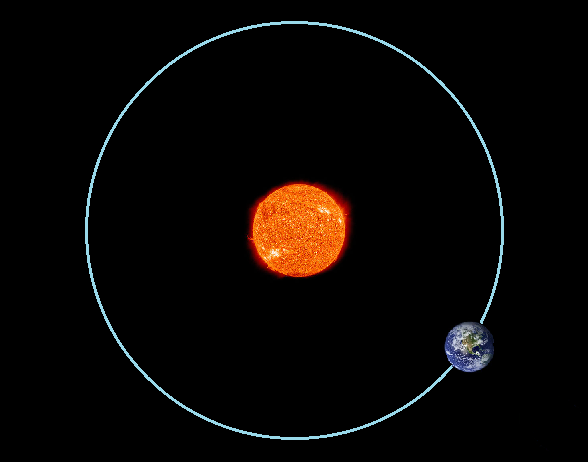
And consider this. At any point in the year, Earth will be somewhere on this circle. Over the course of a year, it’ll travel all the way around. In half a year, it’ll reach the opposite side of its orbit.
Why is that important?
Well…now let’s take a closer look at what parallax is. There’s a simple experiment you can do yourself. Find an object some distance away, perhaps just across the street—preferably a building or tree. Now hold your finger in front of your face.
Now alternate which eye is open…like you’re winking at the tree (or other object), first with your left eye and then with your right.
Notice what happens?

Your finger actually appears to move from left to right.
Your finger isn’t actually moving. You know this because, well, you didn’t move it, did you? I hope not—that’s not how this works. Your finger appears to move because each eye has a slightly different perspective.
If you were a cyclops, or your eyes both somehow shared the exact same space on your face, this wouldn’t work. But when your finger is in front of your nose, both of your eyes can see around it…but each from a different angle.
That’s why your finger seems to actually change position relative to your surroundings. And believe it or not, the same thing works for the Earth.
Think of the opposite sides of its orbit as two eyes.
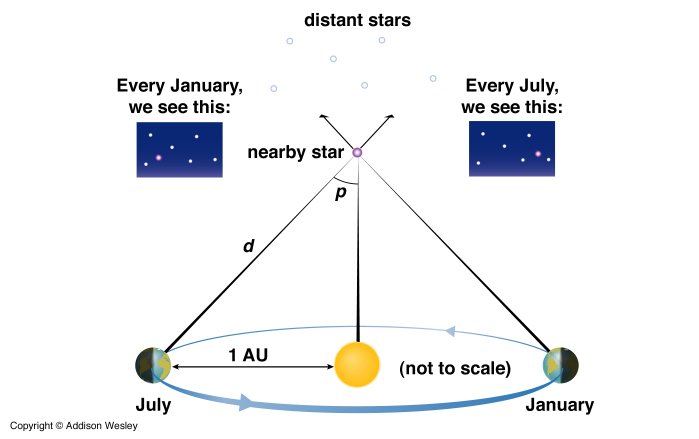
You’ll notice, if you closely observe the sky in one month and then again six months later, some stars will appear to change position a little. That’s because stars aren’t all the same distance from us. More nearby stars act like your finger against the background of more distant stars.
But how does this actually tell us how far away the stars are?
We can use simple trigonometry to calculate that. Notice that the lines in the diagram above form a triangle? The diameter of Earth’s orbit—2 AU—forms the triangle’s baseline, and d and its mirror image in January form the other two sides.
We know the length of our baseline, and we know the angles between it and the other two sides (because, if we’d actually done this, we would have been very careful about what part of the sky we observe).
From there, we can calculate the distance to that nearby star.
There’s just one problem with this method, though. Stars are so far away that after a certain point, whatever parallax we can see isn’t measurable. The stars are shifting in their apparent position from month to month, but not noticeably.
And so we have to resort to another, less accurate method…spectroscopic parallax.
Don’t be fooled by the term “parallax” in its name. It’s just called that because it’s another way of measuring the distance to stars. It doesn’t actually have anything to do with the apparent change in position of a nearby star.
It has everything to do with the spectrum of a much more distant star…and the H-R diagram.

The H-R diagram is possibly the most important graphic in all of astronomy—at least while we’re studying stars. It describes more about stars than you might think.
For example, star temperature and color are plotted along the horizontal axis. The letters O, B, A, F, G, K, and M refer to the seven main spectral types, which are shown on the H-R diagram in order from hottest on the left to coolest on the right.
(Don’t let the term “cool” confuse you, either; even the coolest stars are around 3,000 K, which is 2,727℃.)
The H-R diagram also plots luminosity on the vertical axis. This means the total radiation any one star is emitting, including both visible light and radiation we can’t see. If we could see the full luminosity of stars, most of them would appear much brighter.
The advantage of this diagram is that once a star’s temperature and luminosity are known, we can easily compute its distance.
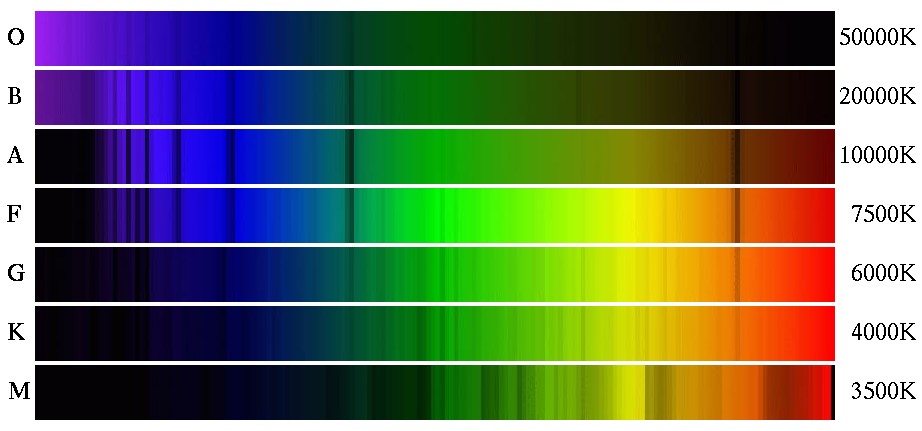
We find a star’s temperature by looking at its spectrum, which is a measure of all radiation from the star. Certain materials in its atmosphere block light at certain wavelengths, producing the dark bands called spectral lines you see here.
Because certain materials can only exist in stars of certain temperatures, this is an easy way to determine its temperature in Kelvins (K)…and we sort stars of certain temperature ranges into the spectral classes you see listed on the left.
We can also figure out a star’s luminosity—or, in this case, luminosity class—by looking at the widths of its spectral lines.
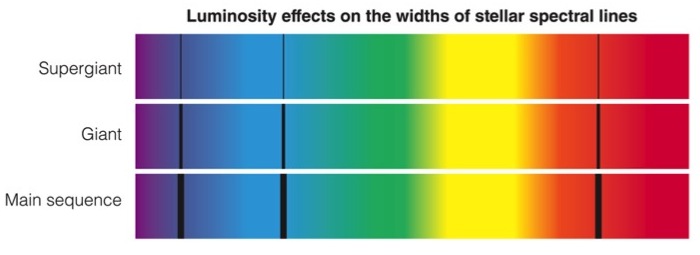
Size has a dramatic effect on spectral lines, so we can tell whether a star is a main-sequence, giant, or supergiant-type star. But more importantly, size has a dramatic effect on the star’s luminosity. Bigger means more luminous.
Now that we know exactly where a star is on the H-R diagram, calculating its distance is a simple matter.
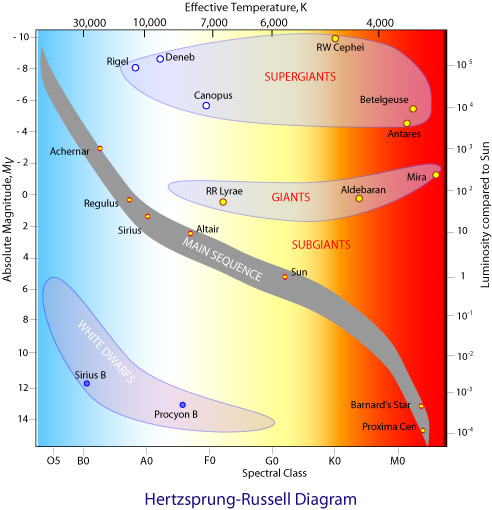
Here’s an H-R diagram with a luminosity scale on the right, and an absolute visual magnitude scale on the left. Absolute visual magnitude is how bright any star would appear to the human eye from 10 parsecs away (32.6 light-years).
All stars are also ranked according to their apparent visual magnitude, which is how bright they appear to the human eye from Earth, regardless of how far away they are.
Now, take special note of the definition of absolute visual magnitude. It’s basically the apparent visual magnitude, if Earth were ten parsecs away from the star. So if we compare the two magnitudes, we can easily find Earth’s actual distance from the star.
Specifically, we subtract absolute magnitude from apparent magnitude. This gives us a distance modulus, which then translates (according to the magnitude-distance formula) to a distance in parsecs.
And thus, we know how far away a star is.
Well…more or less. We know to within a 21% degree of error, which is rather unacceptably large. Measured with parallax, the supergiant Betelgeuse is 131 parsecs away. Measured with spectroscopic parallax, that comes out to 190 parsecs.
But, unfortunately, this is the only way we can measure the distance of more distant stars.